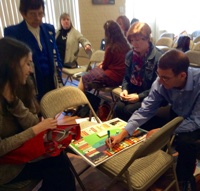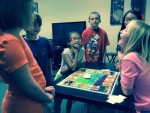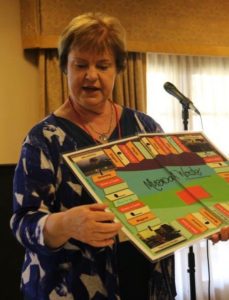Tips & Ideas: Hacking Adjectives & Words
 From Composer/Pianist Alison Mathews
From Composer/Pianist Alison Mathews
I spotted this quite a few years ago and since then have used the idea enthusiastically! It’s been especially useful when preparing for any type of performance, whether in an exam or concert. It’s been a springboard for pupils to find their own descriptive words – we’ve often produced word clouds or used sticky notes on the score.
From Sam Rao, Creator Practicia App
As music teachers we are often prone to feeding endless technical and musical instructions to our students. ”wrist up! shoulders down! play that staccato! you are slowing down here!” While these instructions are great, should we not also be stimulating their creative imaginations so they add character to their interpretations? Well, the board game Musical Words is designed to do just that!
From Dana Rice of Kids and Keys
I wanted to find out if (Musical Words) would work in a private lesson. Kennedy’s song of choice was Fur Elise. This was perfect since she has the song memorized already and she was able to put all her thoughts on interpreting the piece rather than trying to read notes. One of the words I came up with was “popcorn”. Kennedy had a terrific time with that one, playing the whole thing in staccato! On a different turn she landed on the word “Mysterious”. This was pretty easy for her to do considering her song choice of Fur Elise. Another memorable moment in the game was when Kennedy landed on the word “comical”. She began to play Fur Elise with a range of different expressions and then added in some nonsensical chords that just didn’t go with the song at all. The result was indeed comical. She laughed and I laughed at her creative genius.

Four great teacher hacks of the game Musical Words from workshops:
1. Write animal names on the blank spaces. A young student can often quite easily connect to a spider, kitten, hippo, bird, or ???.
2. Write rhythms in the blank spaces. Then, whenever a player lands on a rhythm, they must play a scale, or melody, or more (you decide) using that rhythm.
3. When a player lands on one of the corner spaces or draws a card and is sent there (Concert Hall, Practice Room, Teaching Studio, Recording Studio), try giving them a creative option to get out. If you are stuck in the Concert Hall or Recording Studio the choice might be to perform a section of a piece or sit out a turn. If stuck in the Teaching Studio or Practice Room they might demonstrate a skill or sit out a turn.

From Robyn
I divided the group into 2 teams, they rolled dice to land on a square- if they landed on a word, we discussed what musical elements might portray that adjective (if needed) and then the student improvised for 20 seconds or so to express that idea. If they landed on a quarter note, they played any way they wanted and we had to come up with words to describe it.
From Rosa Conrad
I love the idea of your board game. It reminds me a little of something my teacher at Trinity used to do, called modelling. You had to invent different characters and play your piece the way they would play it.
Gail: Willy Wonka, a Fairy, Superman, The Evil Queen, Ninjas??? The possibilities are endless. I started a new page just for personalities & characters. I’d love to hear your ideas. These would be great to write in the blank spaces on the Musical Words board too!
From Elena Cobb, EVC Composer/Publisher
I always felt that pupils were hesitant to talk about how music makes them feel. In general, they would be only too happy to confirm if they liked, or disliked the piece but even most eloquent, would pause when asked to describe the tone and tonality, character and mood of musical compositions. From the age of five to the age of eighteen the majority would struggle with those elusive adjectives. Modern music scholars are expected to be fluent in the music terminology in all three languages. And yet, they are short of words in their own. To insure a sincere and musically convincing performance from my pupils, I will be asking them in addition to conventional Italian performance directions, to write out a list of adjectives which would best describe the character and mood, form and style in English.Here’s a video from Elena Cobb and her student Kiera of a lesson incorporating musical adjectives.
From Jackie Sharp of Piano Teacher FunMakers
…to get them to describe and copy the tonal quality of what you play (good or bad). Play single notes with rich sound, harsh sound, soft, sweet sound, whatever you like. Give them the words to label these sounds, as well as the tools to create them. Pretty soon, they will develop great critical listening skills.
Gail: You can also play rounds of Musical Words this way.
From Teacher A. F.
My students love to use animals to help them imagine musically. Elephants, Tigers, Fireflies, Snakes. You name it we play it! We have been writing animals in the blanks in Musical Words. Students love to act them out too!
From Jennifer Fox, Clinician, Blogger
Students first wrote down adjectives on the (Musical Words) game board with a white board marker. Then they rolled the dice. When they landed on an adjective they had the choice to sight-read a piece using that adjective or improv something using that adjective. None of my students had their music with them for this particular camp session which is why I decided to go the sight-reading and improv route with the game.
I asked my students if they had any other ideas that might be fun to implement with this game for a future class. Because the action in my grand was taken by my piano technician we used the Clavinova in the studio lab room. This gave one of my students the idea that it would be fun to use the different sounds and instruments the Clavinova provides.
 From Teacher S.
From Teacher S.
My students were working on dynamic and expression marks so we wrote these in the blank spaces on the (Musical Words) board. It made the foreign terms seem real and alive.
For more resources and articles check out the Glossaries, Translators & Other Resources Page
Leave a Reply